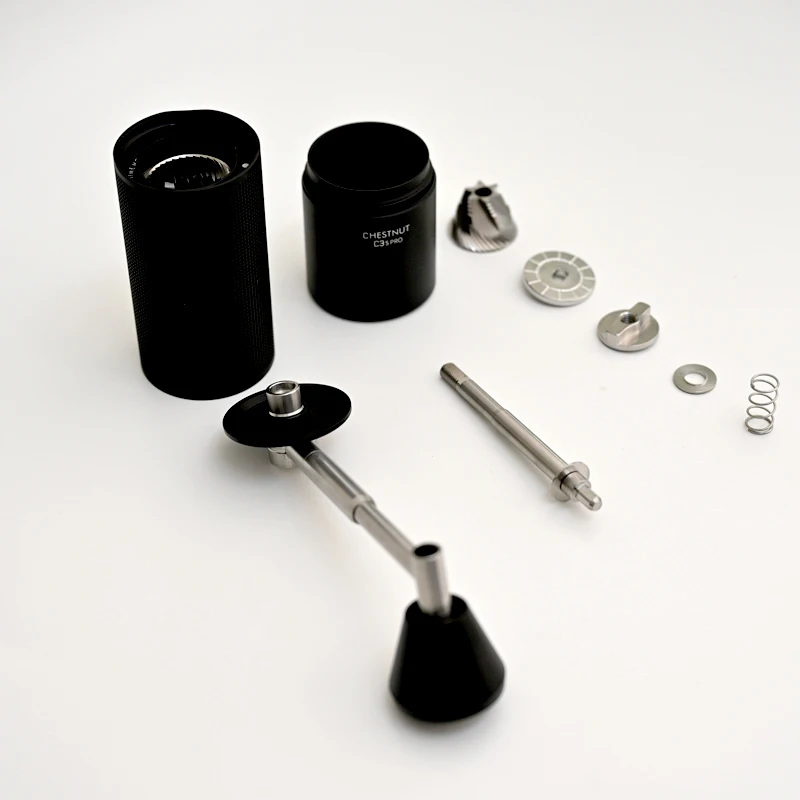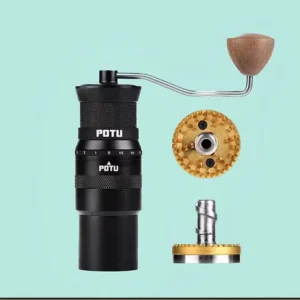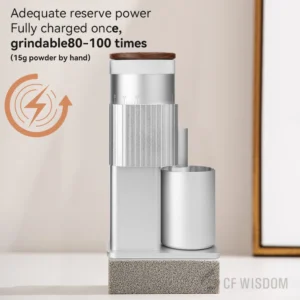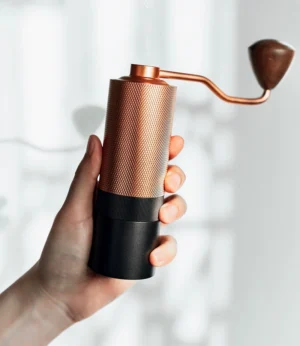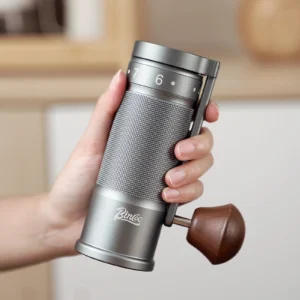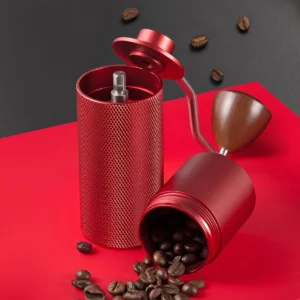Why Fresh Grinding Transforms Your Travel Coffee Experience
There’s nothing quite as disappointing as waking up in a beautiful destination only to start your day with a cup of lackluster, pre-ground coffee. That familiar scenario—where convenience trumps quality—has been the reluctant compromise of coffee lovers on the move for too long.
Yet imagine instead: the rich aroma of freshly ground beans filling your hotel room, campsite, or vacation rental as you prepare a cup that rivals your favorite café back home. This isn’t coffee fantasy—it’s the reality that proper grinding brings to your travel experience.
When coffee beans are ground, they immediately begin to lose their precious aromatic compounds through oxidation. The science is clear: once the protective shell of the whole bean is broken, coffee begins a rapid decline in quality:
- Studies have shown that up to 60% of coffee’s aroma compounds dissipate within just 15 minutes after grinding
- The surface area exposed to oxygen increases by over 10,000 times when beans are ground
- Essential oils responsible for flavor complexity evaporate quickly after grinding
As noted coffee expert Scott Rao explains, “The difference between pre-ground and freshly ground coffee is not subtle—it’s the difference between experiencing coffee as intended or merely a shadow of its potential.”
This freshness factor becomes even more critical with precision brewing methods like the AeroPress. The controlled pressure and short extraction time of the AeroPress specifically highlight the vibrant complexity of freshly ground coffee while mercilessly exposing the flatness of stale grounds. When you combine the portability of an AeroPress with freshly ground beans, even the simplest travel accommodations transform into your personal specialty coffee bar.
The entire travel coffee experience shifts from a compromise to a highlight of your journey when you maintain control over this crucial element. By prioritizing freshly ground coffee, you’re not just packing a brewing device—you’re packing the full sensory experience that makes coffee special in the first place. Exploring travel coffee grinding options becomes the logical next step for anyone serious about elevating their coffee experience away from home.
The AeroPress: Your Perfect Travel Companion
The AeroPress has revolutionized how coffee enthusiasts experience brewing away from home. This ingenious brewing system combines simplicity, durability, and exceptional results in a package small enough to fit in a carry-on or backpack pocket.
What makes the AeroPress particularly suited for travel?
- Lightweight construction at just 8 ounces (227 grams)
- Virtually unbreakable polypropylene material
- No glass components to worry about while packing
- Minimal parts with nothing to lose or break
- Versatility to brew everything from concentrated espresso-style shots to American-style coffee
- Simple cleanup with a quick rinse or push of the plunger
The AeroPress offers remarkable brewing flexibility with both the standard and inverted methods, allowing you to adjust everything from immersion time to water temperature. This adaptability is particularly valuable when dealing with the constraints of travel environments like hotel rooms or camping sites.
However, even with this marvel of coffee engineering, many travelers make a critical mistake: they compromise on the grinding component. Pre-ground coffee might seem convenient, but it sacrifices the very quality that makes the AeroPress worth carrying in the first place. The precision and control the AeroPress offers is wasted without equally precise, fresh grinding.
This realization has led to an entire category of complementary products designed specifically to complete the travel brewing setup. By exploring travel-friendly coffee grinding options, you ensure that your AeroPress can deliver its full potential anywhere your journeys take you. The ideal travel coffee kit requires both brewing and grinding excellence—neither component can be overlooked if you’re seeking café-quality results.
Mastering AeroPress Grind Size: The Key to Perfect Travel Brewing
The AeroPress is remarkably forgiving compared to many brewing methods, but achieving truly exceptional results requires understanding the ideal grind size. For standard AeroPress brewing, you’re aiming for a medium-fine grind—somewhere between what you’d use for drip coffee and espresso.
This optimal grind size resembles table salt in texture: noticeably finer than typical pre-ground coffee for drip machines, but coarser than the powdery consistency of espresso. When rubbed between your fingers, it should feel slightly gritty but not harsh or sharp.
The science behind this recommendation relates directly to extraction dynamics:
- Too fine a grind (like espresso) can create excessive resistance during pressing, requiring tremendous force and potentially causing over-extraction with bitter results
- Too coarse a grind results in under-extraction, producing weak coffee lacking in body and complexity
- The medium-fine sweet spot allows for proper extraction during the typical 1-2 minute brew time while still permitting smooth plunging
However, the “correct” grind size isn’t absolute—it shifts based on your specific brewing approach:
| Brewing Method | Recommended Grind | Brew Time | Notes |
|---|---|---|---|
| Standard AeroPress | Medium-Fine | 1-1.5 min | Balance of clarity and body |
| Inverted Method | Medium | 2-3 min | Longer steep compensates for coarser grind |
| Concentrated/Short | Fine | 30-45 sec | Resembles espresso approach |
| Cold Brew AeroPress | Medium-Coarse | 12+ hours | Prevents over-extraction during long steeping |
Water temperature also influences your grind size choice. When brewing with cooler water (ideal in many travel situations where boiling water isn’t available), a slightly finer grind helps maintain proper extraction. Conversely, when using very hot water, a marginally coarser grind can prevent over-extraction.
Understanding the ultimate espresso grind size chart provides helpful visual references that can be adapted to AeroPress brewing. The principles remain similar, though AeroPress typically requires slightly coarser grinding than true espresso preparation.
The beauty of travel brewing is in experimentation—different water sources, altitudes, and bean origins all influence the ideal grind. Learning to master perfect espresso adjustments gives you the knowledge base to make similar adjustments for AeroPress brewing conditions you encounter while traveling.
Essential Features of Travel Coffee Grinders for AeroPress
Manual vs. Electric: Why Hand Grinders Dominate Travel
When considering travel coffee grinding, manual hand grinders consistently outperform their electric counterparts for several compelling reasons:
- No dependence on electricity or batteries
- Significantly smaller footprint and weight
- Greater durability with fewer breakable components
- Quieter operation (crucial in shared accommodations)
- Often more affordable while delivering equal or better grind quality
While compact electric options like the Timemore Slim and Baratza Encore Go do exist, they come with inevitable compromises: they require power sources, weigh substantially more (often 2-4× heavier), and introduce more potential failure points during travel. For most travelers, general hand coffee grinders provide the optimal balance of performance, convenience, and reliability.
The Burr Advantage: Quality and Consistency on the Go
Not all grinders perform equally, and the mechanism inside makes a tremendous difference to your coffee quality. Burr grinders crush beans between two textured surfaces set a precise distance apart, while blade grinders randomly chop beans with a spinning blade.
For AeroPress brewing—where extraction happens quickly under pressure—consistent particle size is essential:
- Burr grinders produce uniform particles that extract at the same rate
- Blade grinders create a mixture of fine powder and large chunks, resulting in both over and under-extraction simultaneously
- Conical burrs (versus flat) generally offer the best combination of compact size and performance for travel
- Steel burrs tend to be sharper and more durable for travel conditions, while ceramic burrs excel at heat resistance
The difference is not merely theoretical—when you compare burr and blade grinders, you’ll find the former produces noticeably cleaner, more balanced, and more consistent results. This quality gap becomes even more apparent when brewing with methods like AeroPress that highlight both the strengths and flaws in your grind.
Size Matters: The “Fits Inside AeroPress” Gold Standard
The holy grail for AeroPress travelers is finding a grinder that actually fits inside the plunger portion of the AeroPress itself. This clever packing solution effectively makes the grinder “free” in terms of additional pack space:
- The AeroPress plunger has an internal diameter of approximately 2.3-2.4 inches (58-60mm)
- The maximum height for a grinder to fit inside is roughly 5.7 inches (145mm)
- Ideally, handle mechanisms should be removable or foldable
- Capacity matters less than dimensions—most compatible grinders hold 20-30g of beans (perfect for 1-2 AeroPress brews)

This nesting capability transforms what would be two separate items to pack into a single, self-contained brewing system. While it does limit your grinder options somewhat, the space-saving benefit makes it worthwhile for most travelers.
Grind Adjustment: Finding Precision in Portable Form
Travel shouldn’t mean compromising on grind precision. The best portable grinders offer:
- Easy-to-adjust grind settings with clear indicators
- Stepped adjustment mechanisms that resist shifting during travel
- Enough range to handle both finer and coarser settings as needed
- Repeatable settings that allow you to return to your preferred grind after changes
The ability to make small, precise adjustments is particularly important for AeroPress brewing, which typically works best in a narrower grind range than methods like French press or pour-over. Many travelers find that fine adjustment hand grinders provide the control necessary to adapt to different beans and brewing conditions encountered on the road.
Durability and Materials: Built for Adventure
Travel subjects equipment to stresses not typically encountered at home—from being jostled in luggage to exposure to varying temperatures and humidity levels. Superior travel grinders feature:
- Aircraft-grade aluminum or stainless steel housings
- High-quality bearings that maintain alignment despite impacts
- Burr sets that resist dulling even after extensive use
- Minimal plastic components, especially in the grinding mechanism
- Secure threading that won’t loosen during transit
The investment in a stainless steel manual coffee grinder often pays dividends in both longevity and consistent performance throughout years of travel. The initial price difference between premium and budget options typically becomes negligible when amortized over the lifespan of a quality grinder.
Top Manual Coffee Grinders That Fit Inside Your AeroPress
After extensive testing and real-world travel experience, several manual grinders stand out for their exceptional combination of performance and compatibility with the AeroPress. Each grinder below has been evaluated based on grind consistency, build quality, adjustment precision, and ease of use under travel conditions.
Porlex Mini II: The Reliable Classic
The Porlex Mini II has earned its status as a beloved travel companion for AeroPress users worldwide thanks to its straightforward design and dependable performance.
Key Specifications:
* Height: 5.1 inches (130mm)
* Diameter: 2.2 inches (55mm)
* Weight: 8 ounces (227g)
* Capacity: 20g coffee beans
* Burr Type: Ceramic conical
This Japanese-made grinder features ceramic burrs that deliver consistent results in the medium-fine range ideal for AeroPress. The stainless steel body resists impacts and moisture, while the detachable handle makes it perfect for slipping inside the AeroPress plunger.
Pros:
* Excellent fit inside AeroPress
* Durable, lightweight construction
* Good grind consistency for the price
* Minimal static and retention issues
* Simple adjustment system
Cons:
* Slightly slower grinding than premium options
* Limited capacity for larger batches
* Fewer adjustment steps than higher-end models
The Porlex Mini II represents an excellent balance of quality and value, typically priced in the mid-range of travel grinders. Understanding espresso grind settings helps you make the most of this versatile grinder across brewing methods.
1Zpresso Q2: Premium Performance in Tiny Package
For travelers willing to invest more for superior grind quality, the 1Zpresso Q2 stands as perhaps the finest compact grinder available today.
Key Specifications:
* Height: 5.5 inches (140mm)
* Diameter: 2.1 inches (53mm)
* Weight: 13 ounces (369g)
* Capacity: 20g coffee beans
* Burr Type: 38mm stainless steel conical
The Q2 features premium 38mm stainless steel burrs that produce exceptionally uniform particles across the entire grind spectrum. Its robust construction and precision manufacturing result in minimal wobble and outstanding consistency.
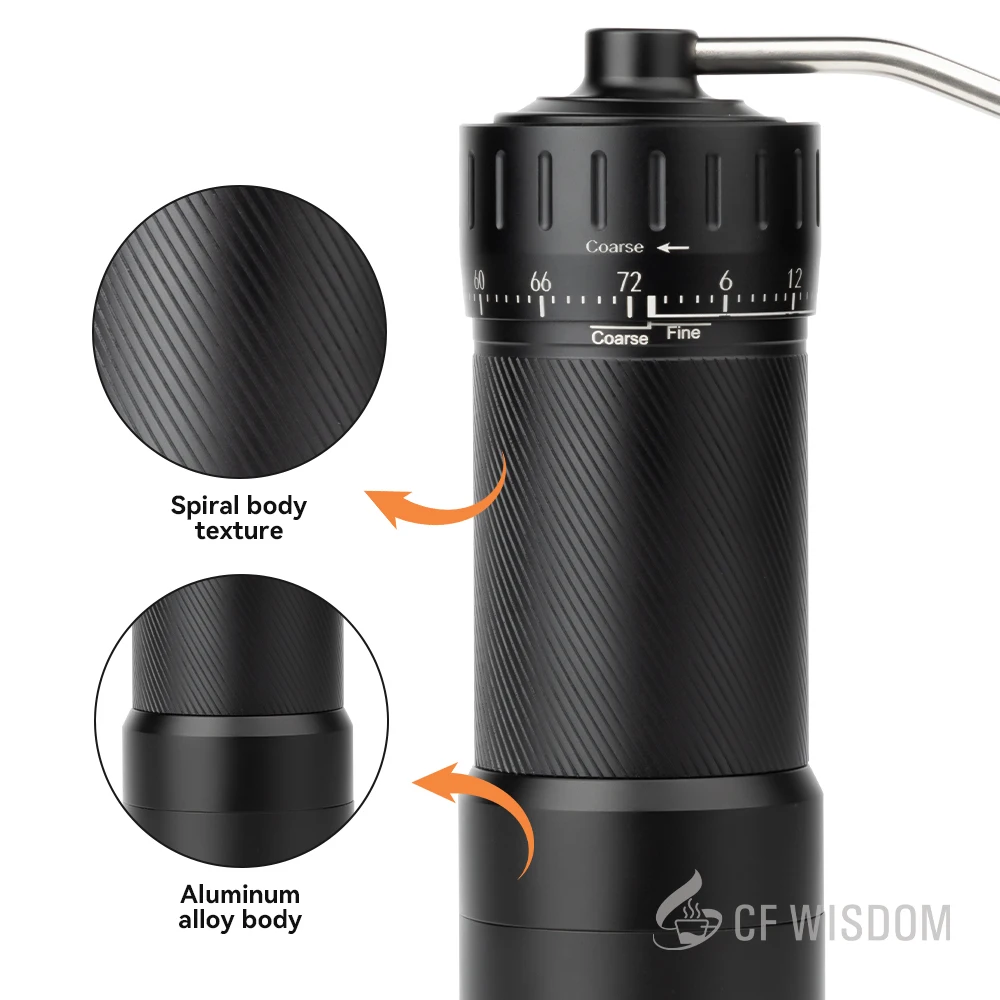
Pros:
* Superior grind consistency rivaling electric grinders
* Impressive build quality with premium materials
* Smooth, efficient grinding action requiring less effort
* Precise adjustment with 60+ settings
* Excellent customer support and parts availability
Cons:
* Higher price point than most travel options
* Slightly heavier than competitors
* Might be tight fit in some AeroPress models
While the Q2 represents a higher investment (typically in the premium price tier), its performance justifies the cost for serious coffee enthusiasts. The grind quality noticeably elevates the final cup, especially when brewing with exceptional single-origin beans.
Timemore Chestnut C2/Nano: Elegant Design Meets Functionality
The Timemore Chestnut C2 (and its even more compact sibling, the Nano) deliver impressive performance in an aesthetically pleasing package.
Key Specifications:
* Height: 5.9 inches (150mm) for C2, 5.3 inches (135mm) for Nano
* Diameter: 2.2 inches (56mm)
* Weight: 14 ounces (397g) for C2, 13 ounces (369g) for Nano
* Capacity: 25g for C2, 20g for Nano
* Burr Type: 38mm stainless steel conical with diamond-like coating
Timemore has gained a strong reputation for combining aesthetic appeal with practical performance. The diamond-like coating on the steel burrs enhances durability and sharpness, while the refined design makes grinding a pleasure rather than a chore.
Pros:
* Excellent grind consistency, especially at medium settings
* Attractive design with premium materials
* Diamond-like coated burrs for extended sharpness
* Smooth, fast grinding action
* Good value for the quality offered
Cons:
* Standard C2 may be slightly too tall for some AeroPress models (Nano recommended)
* Adjustment system has learning curve
* Wooden handle options require more care in high-humidity environments
Typically priced in the upper-mid range, the Timemore grinders represent excellent value for their performance level and build quality.
Knock Aergrind: Purpose-Built for AeroPress
As its name suggests, the Knock Aergrind was specifically designed to pair with the AeroPress, making it a natural fit for travelers seeking perfect compatibility.
Key Specifications:
* Height: 5.1 inches (130mm)
* Diameter: 2.2 inches (56mm)
* Weight: 12 ounces (340g)
* Capacity: 25g coffee beans
* Burr Type: 38mm steel conical
Made in the UK, the Aergrind features precision-engineered components with tight tolerances that produce exceptional grind consistency. Its stepless adjustment mechanism offers infinite control over grind size.
Pros:
* Designed specifically to fit inside AeroPress
* Outstanding build quality with precision engineering
* Excellent grind consistency across settings
* Infinite adjustment capability
* Made in the UK with direct manufacturer support
Cons:
* Often limited availability
* Premium pricing
* Stepless adjustment requires careful tracking of settings
The Aergrind typically falls into the premium price category but delivers professional-level grinding capability in a travel-friendly package. Knowing how to dial in the correct grind setting for espresso helps leverage its precision adjustment system effectively.
Comprehensive Comparison: Choosing Your Perfect Travel Grinder
To help you make an informed decision, this comparison table highlights the key differences between the top AeroPress-compatible grinders:
| Feature | Porlex Mini II | 1Zpresso Q2 | Timemore Nano | Knock Aergrind |
|---|---|---|---|---|
| Fits inside AeroPress | Yes | Yes | Yes | Yes |
| Burr Type | Ceramic conical | Steel conical | Steel conical | Steel conical |
| Weight | 8 oz (227g) | 13 oz (369g) | 13 oz (369g) | 12 oz (340g) |
| Capacity | 20g | 20g | 20g | 25g |
| Adjustment | Stepped (12) | Stepped (60+) | Stepped (36) | Stepless |
| Materials | Stainless steel | Aluminum/steel | Aluminum/steel | Aluminum/steel |
| Price Range | Mid | Premium | Upper-mid | Premium |
| Grind Consistency | Good | Excellent | Very good | Excellent |
| Ease of Use | Very easy | Easy | Moderate | Moderate |
| Travel Durability | Excellent | Very good | Good | Very good |
This comparison reveals several patterns worth noting:
For travelers prioritizing minimal weight and simplicity, the Porlex Mini II remains an excellent choice despite being slightly outperformed in grind consistency by newer models. Its proven durability and straightforward design make it particularly suitable for adventurous travel.
Those seeking the absolute best grind quality should consider either the 1Zpresso Q2 or the Knock Aergrind, with the former offering more adjustment steps and the latter providing infinite precision through its stepless design. Both deliver cup quality that rivals much larger electric grinders.
The Timemore Nano hits a sweet spot of performance, aesthetics, and value, making it perhaps the most balanced option for travelers who appreciate design alongside function.
Budget-conscious travelers should know that the performance gap between the Porlex and premium options is noticeable but not dramatic—you’ll still achieve excellent results with the more affordable option. For specialists seeking grinders capable of true espresso preparation, our manual coffee grinders for espresso collection offers suitable options.
Excellent Compact Travel Grinders (Beyond AeroPress Fit)
While the ability to nest inside an AeroPress represents the ultimate space efficiency for travelers, several exceptional grinders that don’t quite fit this criterion deserve consideration for their outstanding performance benefits.
Comandante C40 MK4: The Gold Standard
Though too large to fit inside the AeroPress, the Comandante C40 is regarded by many coffee professionals as the finest hand grinder available, period.
Key Travel Benefits:
* Unmatched grind consistency across all settings
* Exceptional build quality ensuring years of travel use
* Significantly faster grinding speed than compact models
* Larger capacity (40g) allowing preparation of multiple servings
* Comprehensively tested burr set with minimal fines production
The Comandante’s slightly larger size (approximately 6.7 × 2.4 inches or 170 × 60mm) requires separate packing but rewards you with noticeably superior cup quality, especially with lighter roasts where extraction precision matters most.
Kinu M47 Traveler: Engineered for the Road
Designed specifically with portability in mind (though still too large for AeroPress nesting), the Kinu M47 Traveler offers professional-grade performance in a travel-optimized package.
Key Travel Benefits:
* Removable handle that stores separately for compact packing
* All-metal construction built to withstand travel conditions
* Zero retention design that wastes no coffee
* Exceptional consistency rivaling commercial grinders
* Intuitive and precise adjustment mechanism
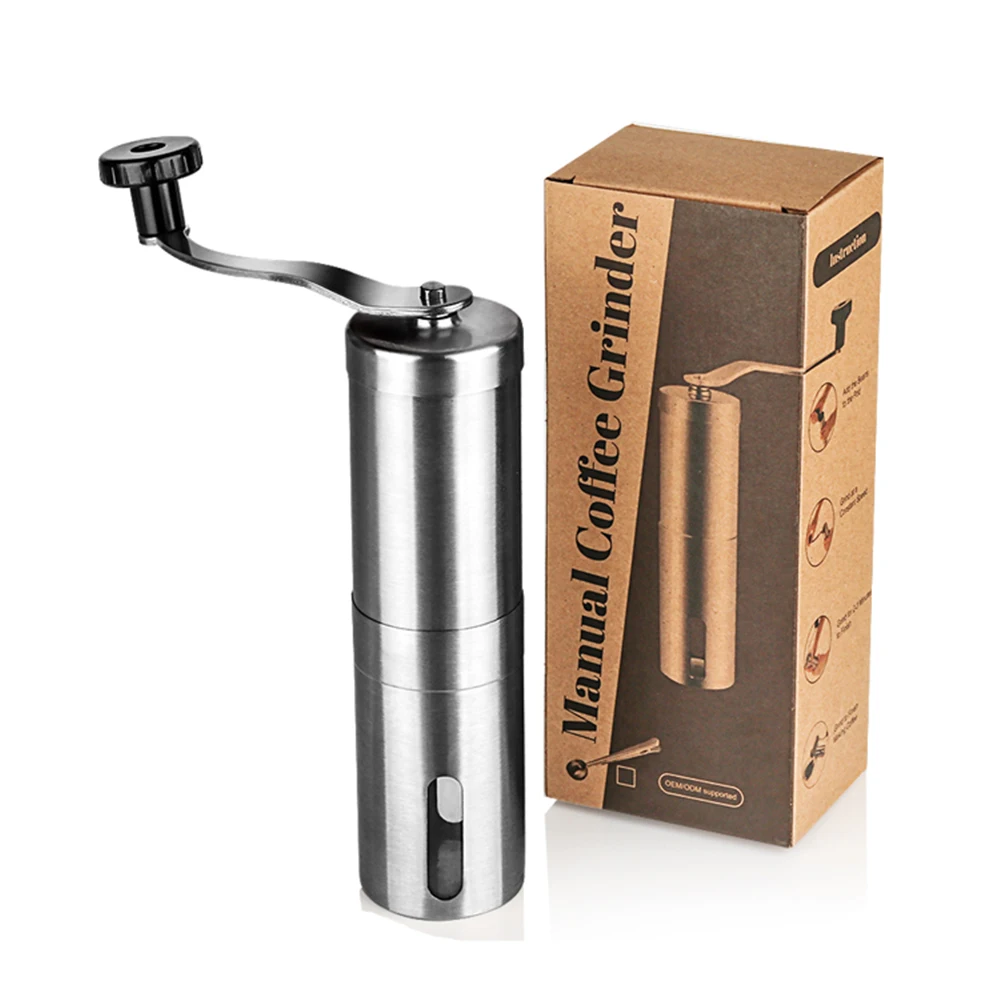
1Zpresso K-Plus: Versatility Champion
Slightly larger than AeroPress-fitting models, the K-Plus offers a significant performance upgrade for travelers willing to allocate a bit more space.
Key Travel Benefits:
* External grind adjustment dial with clear numbered settings
* Magnetic catch cup for secure bean collection
* Larger 48mm burrs for faster grinding (crucial when traveling)
* Extended capacity for serving groups
* More comfortable grinding ergonomics for daily use
While these grinders require separate packing space, their performance advantages may outweigh the convenience of AeroPress nesting for serious coffee enthusiasts. Each delivers cup quality comparable to commercial café grinders many times their size and price. For more options that balance performance and portability, explore our selection of portable coffee grinders.
Expert Grinding Technique: Mastering Your Manual Grinder
Achieving optimal results with your travel grinder requires proper technique—a skill that quickly becomes second nature with practice.
Bean Measurement Without Scales
While weight-based measurement is ideal, traveling without scales doesn’t mean sacrificing precision:
- A level AeroPress scoop holds approximately 14g of medium-roast beans
- A standard tablespoon contains roughly 7g of whole beans
- Most grinder chambers hold about 20-25g when filled to capacity (without compressing)
- Pre-count beans at home to develop visual memory of your typical dose
Efficient Grinding Process
- Hold the grinder firmly between your knees while seated, or against a stable surface
- Use your dominant hand for turning the handle
- Maintain a steady, moderate pace rather than fast, irregular movements
- Turn clockwise with consistent pressure—each full rotation should take about 1 second
- Avoid the temptation to check progress frequently, as this interrupts rhythm
Body Mechanics and Positioning
- Keep your wrist straight while turning to prevent fatigue
- Use your entire arm rather than just wrist movement
- For longer grinding sessions, switch hands halfway through
- When seated, brace the grinder between your thighs for stability
- On uneven surfaces (like hiking trails), sit and stabilize the grinder between your feet
Time Expectations and Efficiency
For a typical 16g AeroPress dose at medium-fine setting:
* Entry-level grinders (Porlex, Hario): 90-120 seconds
* Mid-range grinders (Timemore, 1Zpresso Q): 60-75 seconds
* Premium grinders (Comandante, Kinu): 45-60 seconds
Understanding the principles behind the 30-second espresso rule helps you appreciate why consistent grinding technique matters—extraction is fundamentally influenced by particle size distribution, which your grinding approach directly affects.
Troubleshooting Common Issues
- Inconsistent grind: Check for wobbling burrs or loose adjustment ring
- Excessive effort required: Likely grinding too fine or beans are too dark/oily
- Beans not feeding properly: Shake grinder slightly while grinding
- Burr binding: Immediately stop and check for foreign objects
With proper technique, manual grinding becomes not just efficient but genuinely enjoyable—a mindful ritual that connects you more deeply to your brewing process while traveling.
Packing and Protecting Your AeroPress Grinding Setup
Strategic packing is essential for protecting your coffee equipment while maximizing space efficiency during travel.
Nesting Your Grinder Inside the AeroPress
For compatible grinders (Porlex Mini, 1Zpresso Q2, Timemore Nano, Aergrind):
* Remove the handle from your grinder and store it alongside the stirrer
* Place the grinder body inside the AeroPress plunger
* Secure with a small piece of clothing or the AeroPress funnel to prevent movement
* Cap the open end with a small sock or soft pouch
Protection Strategies for Burrs and Adjustment Mechanisms
- Return the grinder to a middle setting (neither fully fine nor coarse) for travel
- Consider placing a few beans in the chamber to prevent burr movement
- For premium grinders, use the included protective caps or covers
- Avoid over-tightening adjustment rings before packing
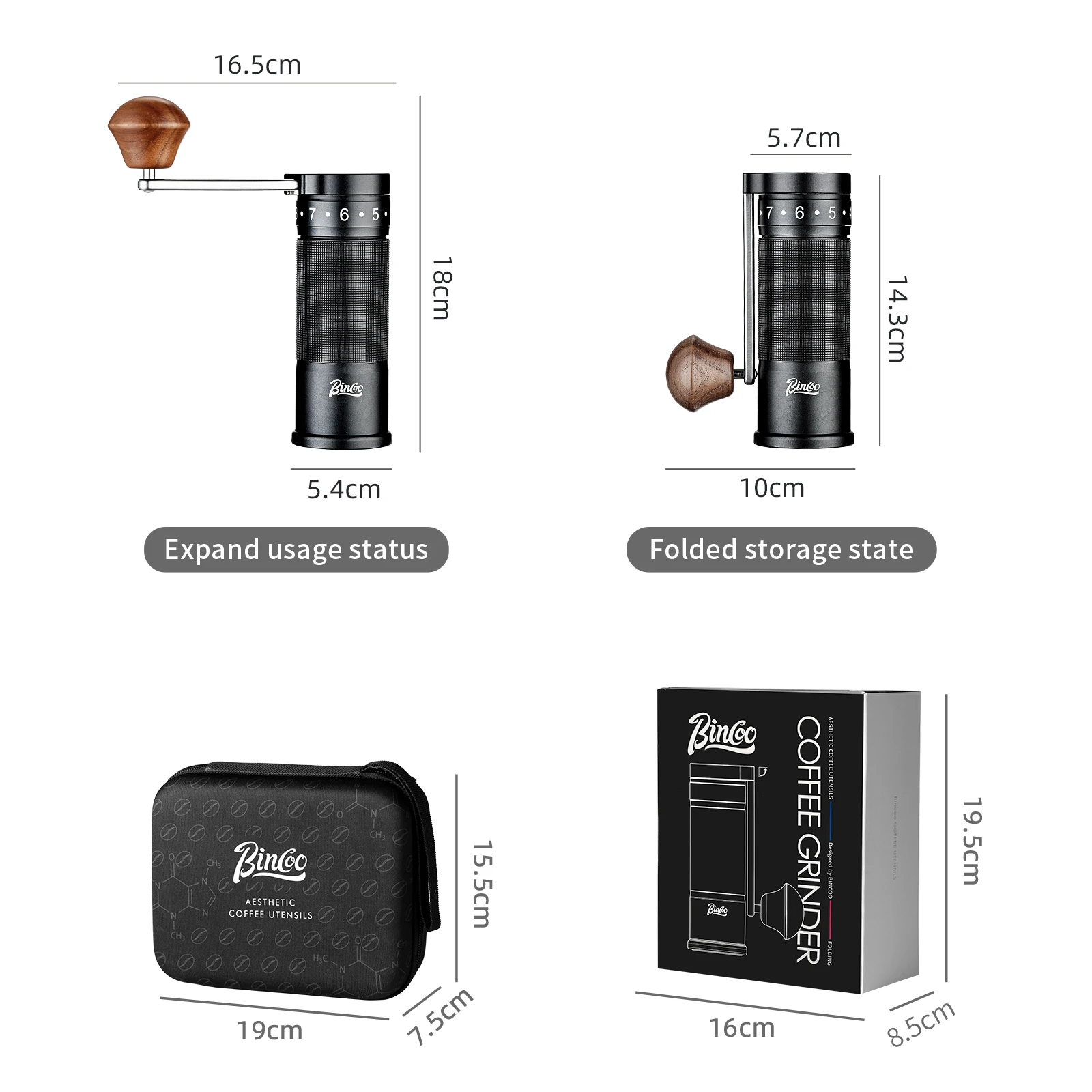
Creative Packing Solutions
- Use the AeroPress funnel as a protective sleeve for the grinder handle
- Store paper filters in a small ziplock bag compressed inside the AeroPress cap
- Utilize the space inside the bean chamber for small items like extra gaskets
- Wrap the entire assembled package in a small travel towel for extra protection
Space-Efficient Configurations
The most compact packing arrangement requires:
* AeroPress with plunger compressed
* Grinder inside plunger
* Filters and accessories distributed in remaining spaces
* Total footprint: approximately 4.5 × 4.5 × 6 inches (11.5 × 11.5 × 15cm)
This complete setup occupies roughly the same space as a small water bottle or travel umbrella. For additional perfectly-sized options, explore our handheld coffee grinder collection designed with travel efficiency in mind.
Coffee Bean Storage Solutions for Travelers
Maintaining bean freshness presents unique challenges when traveling, but several effective solutions exist:
Airtight Containers with One-Way Valves
- Small silicone or stainless steel containers with valves allow CO₂ release without letting oxygen in
- Ideal for trips of 1-2 weeks where beans will continue degassing
- Examples include the Airscape Small, Fellow Atmos Small, or purpose-made coffee vaults
Pre-Dosing Strategy for Extended Trips
- Prepare individual doses (typically 15-20g) in small ziplock bags
- Remove as much air as possible before sealing
- Label with origin/date if bringing multiple varieties
- Store all doses in a larger airtight container
Fine Adjustment Hand Grinder, Precision Manual Grinder, Travel Coffee Grinder
Price range: $185.11 through $494.63 Select options This product has multiple variants. The options may be chosen on the product pageHand Burr Grinder, Hand Crank Coffee Grinder, Manual Espresso Grinder, Portable Coffee Grinder
Price range: $262.72 through $300.22 Select options This product has multiple variants. The options may be chosen on the product pageManual Burr Mill, Manual Coffee Grinder Stainless Steel, Manual Coffee Mill Grinder, Mechanical Coffee Grinder
Price range: $127.26 through $130.32 Select options This product has multiple variants. The options may be chosen on the product pageHand Burr Grinder, Manual Coffee Grinder Stainless Steel, Precision Manual Grinder
Price range: $183.64 through $187.52 Select options This product has multiple variants. The options may be chosen on the product page
Vacuum-Sealed Options
- For longer trips, consider vacuum-sealing weekly portions
- Small hand-pump vacuum containers preserve freshness effectively
- Resealable valve bags (like those from many specialty roasters) offer good intermediate protection
Environmental Challenges
Different travel environments affect coffee freshness in distinct ways:
- High humidity accelerates staling—prioritize water resistance in your storage solution
- Altitude changes can cause bag expansion—allow some headspace in containers
- Temperature fluctuations promote condensation—choose containers that minimize air space
For travelers planning longer journeys, a useful approach is to bring beans for the first week, then seek out local roasters for fresh supplies—a strategy that both maintains quality and enriches your travel experience through coffee exploration. Our selection of compact coffee mills pairs perfectly with proper bean storage for optimal freshness preservation.
Clean and Maintain Your Grinder on the Road
Proper maintenance ensures consistent performance throughout your travels while preventing flavor contamination between different coffee varieties.
Essential Cleaning Tools for Travel
- Small cleaning brush (many premium grinders include one)
- Microfiber cloth that doubles as protective wrapping
- Compressed air capsule or small bulb blower
- Unscented rice for deep cleaning (available almost anywhere)
Quick Daily Cleaning Routine
- Tap the grinder gently to dislodge loose grounds
- Brush visible grounds from burrs and chamber
- Run 5-10 gentle pumps with the handle to clear retention points
- Wipe exterior with microfiber cloth to remove oils and moisture
This 30-second routine prevents buildup and maintains consistent grind quality.
Addressing Static and Retention Issues
- The “Ross Droplet Technique”: Add a single drop of water to beans before grinding
- Small puffs of breath into the chamber can reduce static (the moisture helps)
- Tap grinder firmly against palm after grinding to dislodge retained grounds
- For stubborn retention, disassemble upper burr carrier for access
Deep Cleaning Procedure for Longer Trips
- Disassemble grinder according to manufacturer guidelines
- Brush all visible coffee residue from burrs and chambers
- For thorough cleaning, grind a small amount (5-10g) of uncooked rice
- Reassemble carefully, ensuring proper burr alignment
- Run a few beans through at coarse setting to remove any rice dust
For comprehensive guidance on preserving your investment, our guide on maintaining manual coffee grinders provides detailed procedures for each major grinder type.
Is Your Grinder TSA-Friendly? Flying with Coffee Equipment
Q: Can I bring my manual coffee grinder in carry-on luggage?
A: Yes, manual coffee grinders are generally allowed in carry-on luggage. The TSA and most international security agencies classify them as kitchen utensils rather than prohibited items.
Q: Should I pack my grinder in checked or carry-on baggage?
A: Carry-on is strongly recommended. Manual grinders contain precision parts that can be damaged by rough handling in checked luggage. Additionally, their compact size makes them easy to include in carry-on bags.
Q: Do I need to remove my grinder from my bag during security screening?
A: It’s not typically required, but being prepared to remove it can speed up screening. The dense metal components may trigger additional screening.
Q: What documentation might help explain unusual equipment?
A: Having the product packaging image on your phone can help explain the purpose of the device to security agents unfamiliar with specialty coffee equipment.
Q: Are there country-specific considerations?
A: Most countries treat coffee grinders similarly to other kitchen tools, but some enhanced security countries (like Israel) may require more thorough explanation. Allow extra screening time when traveling through high-security airports.
Q: What’s been the real experience of travelers?
A: The vast majority of coffee enthusiasts report no issues bringing manual grinders through security. The occasional questions are easily resolved with a brief explanation or demonstration of the device’s function.
Understanding how to make appropriate manual and automatic grinder setting adjustments can be particularly helpful when traveling between different locations where environmental factors might affect your brewing.
What if You Can’t Bring a Grinder? Alternative Approaches
While fresh grinding produces optimal results, certain situations may prevent carrying a grinder. Here are effective alternatives:
Finding Local Coffee Resources
- Research specialty coffee shops at your destination before traveling
- Many quality cafés will grind beans to your specification if you purchase from them
- Some hotels and accommodations now offer grinder loans or access to grinding equipment
Pre-Ground Strategies When Necessary
- If you must pre-grind, do so immediately before departure
- Use airtight, vacuum-sealed containers with one-way valves
- Portion grounds into single-serve packages to minimize repeated exposure to air
- Consider slightly coarser grinds than ideal—they deteriorate more slowly than finer grinds
Preserving Quality with Pre-Ground Coffee
- Vacuum-sealed packages preserve freshness significantly longer than traditional storage
- Oxygen absorber packets can extend viability of pre-ground coffee
- Store in cool, dark conditions whenever possible
- Consider packaging with inert gas displacement for maximum preservation
When working with pre-ground coffee, adjusting your AeroPress technique can help compensate for freshness issues:
* Shorter brew times (60-75 seconds) minimize extraction of stale notes
* Slightly lower water temperatures (185°F/85°C) emphasize sweetness over potentially papery flavors
* Gentle stirring rather than aggressive agitation prevents over-extraction
Our guide to mastering espresso grind size offers additional insights on adjusting brewing parameters when grinding conditions aren’t ideal.
Complete Your Travel Coffee Kit: Beyond Grinding
While the grinder and AeroPress form the core of your travel setup, several complementary items can elevate your brewing experience:
Heating Solutions
- Collapsible silicone kettles pack flat and work with most power sources
- Immersion heaters provide quick heating in cups or small vessels
- Dual-voltage travel kettles eliminate converter needs for international travelers
- For outdoor adventures, compact camp stoves with precise temperature control
Precision Without Bulk
- Pocket digital scales with 0.1g precision weigh less than 5 ounces
- Collapsible silicone drip trays prevent countertop mess
- Dual-purpose mugs with measurement markings reduce needed equipment
Filter and Water Considerations
- Reusable metal AeroPress filters eliminate paper waste and pack flat
- Paper filters can be pre-wet and dried for packing efficiency
- Portable water filters or treatment drops ensure quality brewing water
- Compact third wave water mineral packets optimize extraction with local water sources
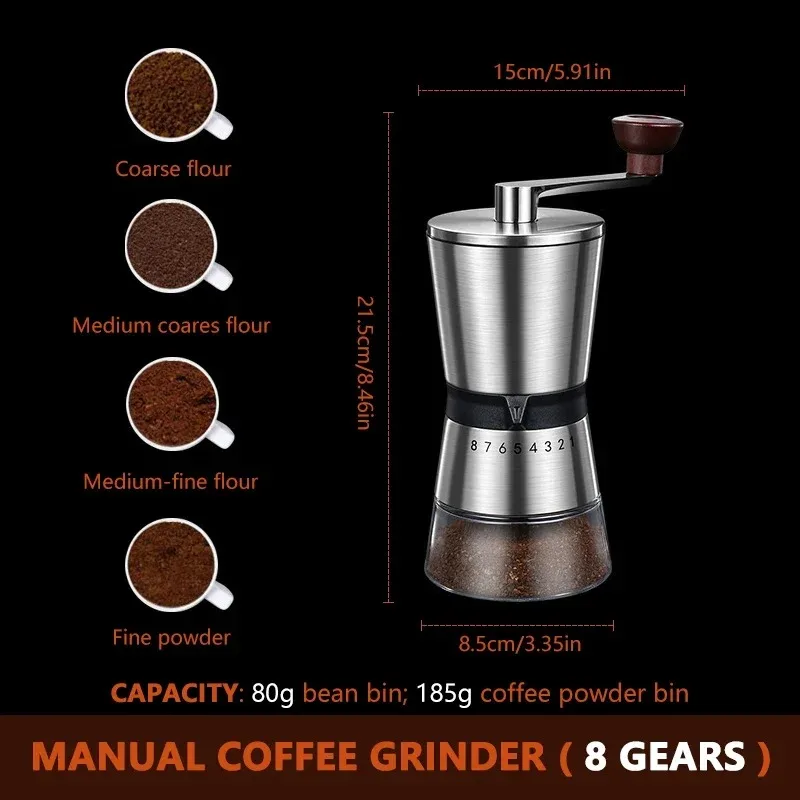
Multi-Purpose Solutions
- Insulated travel mugs that double as brewing vessels
- Combined coffee storage and measuring devices
- Multi-tool coffee accessories that integrate tampers, scoops and levelers
When assembling your kit, each component should earn its place through functionality and compatibility with your brewing style. Understanding the perfect grind setting for espresso principles helps you maximize the performance of your travel setup across different brewing conditions.
Brewing Recipes: Optimized for Travel and Fresh Grinding
These tested recipes are specifically designed for travel scenarios where you’re brewing with freshly ground coffee using a manual grinder and AeroPress:
Standard Travel AeroPress Recipe
Ingredients:
* 16g freshly ground coffee (medium-fine setting, 12-15 on Timemore C2, 2.0-2.2 on Porlex Mini)
* 240g water at 195°F (90°C)
Equipment:
* AeroPress (standard orientation)
* Manual grinder
* Timer
Method:
1. Insert plunger slightly into AeroPress tube for stability
2. Add freshly ground coffee to chamber
3. Start timer and add 50g water, stir gently for 10 seconds
4. Add remaining 190g water and attach filter cap
5. At 1:10, flip AeroPress and begin gentle pressing
6. Finish press by 1:30
7. Dilute with additional hot water if desired
Notes: This recipe works exceptionally well with medium-roast beans and is forgiving of minor variations in grind consistency that might occur during travel.
Travel Concentrate Recipe (For Multiple Servings)
Ingredients:
* 22g freshly ground coffee (medium setting, 16-18 on Timemore C2, 2.5 on Porlex Mini)
* 100g water at 200°F (93°C)
Method:
1. Use inverted AeroPress method
2. Add ground coffee, then water
3. Stir thoroughly for 15 seconds
4. Steep for 1:30 total
5. Press slowly, aiming to finish at 2:00
6. Result yields approximately 80g concentrate
7. Dilute with 120-160g hot water per serving (adjusting to taste)
Notes: This approach allows sharing between two travelers or saving half for later, and works particularly well with darker roasts.
Hotel Room Recipe (Limited Equipment)
Ingredients:
* 18g freshly ground coffee (medium-fine setting)
* 220g hot water (from hotel kettle, allowed to cool 30 seconds)
Method:
1. Standard orientation with AeroPress on sturdy cup
2. Add grounds, then all water at once
3. Stir firmly 10 times
4. Attach filter cap
5. Press immediately with steady pressure
6. Aim to complete pressing in 30-45 seconds
7. Enjoy as is or dilute slightly
Notes: This faster recipe compensates for the typically less-than-ideal water temperature from hotel kettles, which often don’t reach proper brewing temperature.
The principles in beyond numbers perfect espresso grind apply equally to travel brewing—sometimes visual and tactile assessment of your grind matters more than specific numerical settings.
How Your Grinder Choice Affects Your Travel Experience
Your choice of coffee grinder shapes your travel experience in ways that extend far beyond the cup quality itself.
Consider the traveler using an ultralight Porlex Mini. Its minimal weight and compact design allow for spontaneous detours and unplanned adventures without the burden of heavy equipment. This traveler values flexibility and mobility, with coffee quality as an important but not singular priority. Grinding takes slightly longer but becomes a mindful morning ritual—a moment of pause before the day’s explorations.
Contrast this with someone choosing the premium 1Zpresso Q2, who prioritizes exceptional cup quality regardless of location. The additional few ounces represent a worthwhile tradeoff for the significantly improved flavor clarity and complexity. This traveler finds deep satisfaction in creating café-quality coffee in remote locations, with the grinding process being quicker and more effortless.
The grinder choice also influences social dynamics. A well-designed, efficient grinder makes preparing coffee for travel companions a pleasure rather than a chore. There’s something remarkably satisfying about sharing freshly ground, expertly brewed coffee with friends while watching a sunrise from a mountain overlook or preparing for a day of urban exploration.
Beyond the practical aspects, your grinder becomes part of your travel identity and routine. Like a favorite travel garment or trusted bag, it becomes a companion that feels increasingly personal with each journey. Coffee enthusiasts often report that their travel grinder evolves from mere equipment to something approaching a talisman—a consistent element in the ever-changing landscape of travel.
Perhaps most significantly, the ability to create excellent coffee anywhere fosters a deeper sense of self-sufficiency and engagement with your surroundings. Rather than starting each day with a rushed search for acceptable coffee, you create a personal ritual that grounds you in unfamiliar environments, creating a moment of familiar comfort before venturing into the new and unknown.
FAQ: Common Questions About Grinding for AeroPress Travel
Can I use espresso grind in my AeroPress while traveling?
While the AeroPress can handle espresso-fine grinds, this isn’t ideal for travel brewing. True espresso grinds require significantly more pressure than the AeroPress can generate and will likely result in over-extraction and excessive resistance during pressing. Instead, aim for a medium-fine grind (slightly coarser than espresso) for optimal extraction under normal AeroPress pressure.
How long will hand grinding take during travel?
With a quality grinder, preparing a typical 16g dose for AeroPress takes approximately:
* Entry-level grinders: 90-120 seconds
* Mid-range grinders: 60-75 seconds
* Premium grinders: 45-60 seconds
This time investment becomes part of the brewing ritual rather than a significant delay.
What’s the minimum grinder quality I should consider?
At minimum, choose a grinder with actual burrs (not blades) and a reasonably consistent grind output. The Porlex Mini represents a good quality floor—grinders significantly cheaper typically compromise too much on consistency and durability for travel use. Remember that even a basic burr grinder with freshly ground coffee will produce better results than pre-ground coffee.
How do altitude changes affect grinding and brewing?
Higher altitudes have two main effects: water boils at lower temperatures (approximately 1°F less per 500ft/150m above sea level), and lower atmospheric pressure slightly affects extraction dynamics. To compensate:
* At high altitudes: Grind slightly finer and extend brew time
* At very high altitudes (above 5,000ft/1,500m): Consider water temperature stability more carefully
Can I use my travel grinder at home between trips?
Absolutely! Travel grinders make excellent home grinders, especially for single serving brewing. Many coffee enthusiasts discover they prefer their compact manual grinder for everyday use. The smaller capacity becomes the only limitation for larger batch brewing.
How do I adjust my grind for different water sources?
Different mineral content in water significantly impacts extraction:
* For soft water: Grind slightly finer to increase extraction
* For hard water: Grind slightly coarser to prevent over-extraction
* For filtered or bottled water: Standard grind settings usually work well
If you’re uncertain about local water quality, medium mineral content bottled water produces the most consistent results.
Is it worth investing in a premium grinder for occasional travel?
This depends on your priorities. If you travel only occasionally but value exceptional coffee, a premium grinder like the 1Zpresso Q2 or Timemore Nano offers the best balance—compact enough for travel but with performance that justifies everyday home use between trips. For frequent travelers who prioritize minimum weight and maximum durability, the Porlex Mini remains an excellent choice despite slightly lower grind quality.

